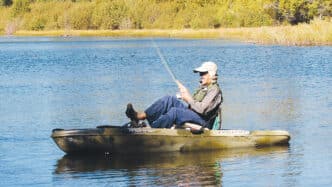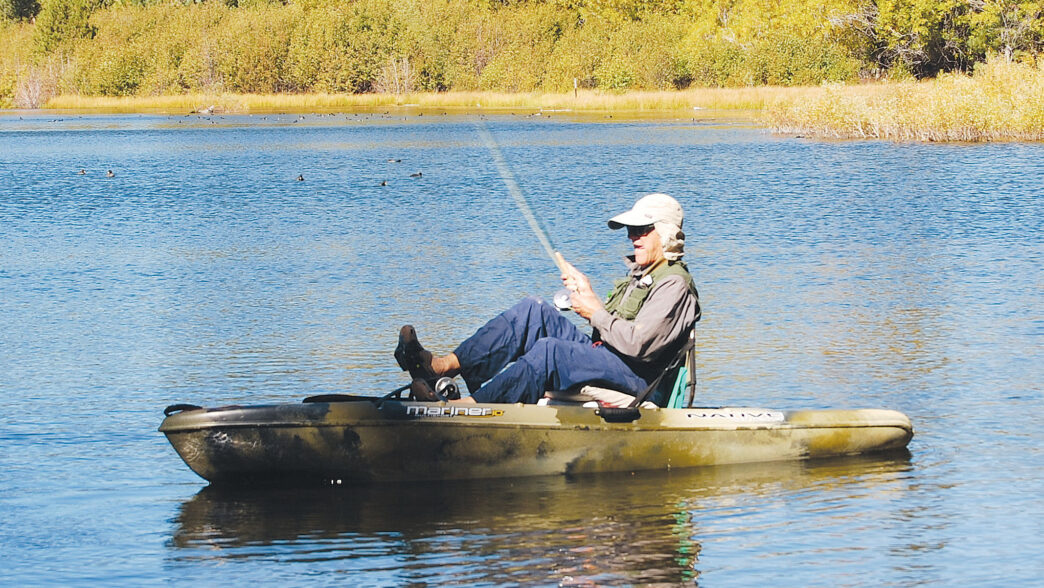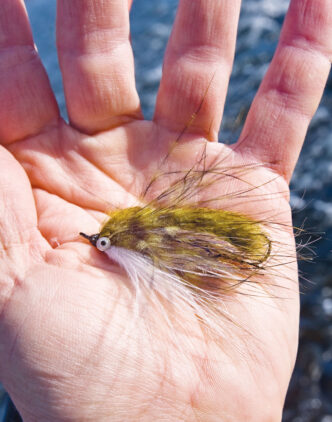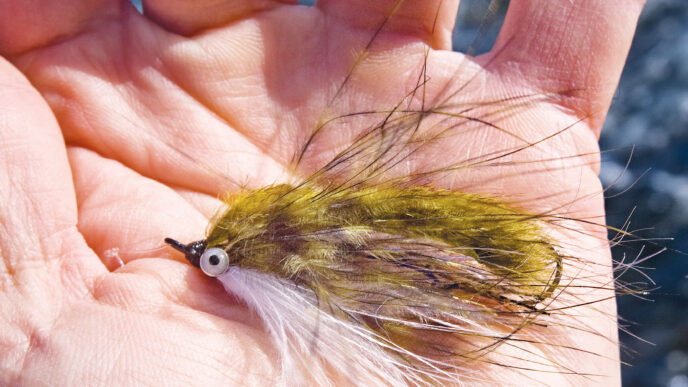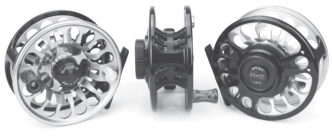I currently have five craft for fly fishing still waters: three float tubes, one float tube–pontoon boat hybrid, and one fly-fishing kayak. Here’s how I got to this point. (My wife is also interested in my explanation.)
By “craft,” I am referring only to muscle-powered boats. There are those who fish still waters from motor-powered platforms, whether driven by electric motors on pontoon boats, prams, and the like or by regular gas motors on larger boats. But I believe the simpler, the better. Plus, there are health benefits from using your body to get about. There are some definite downsides, as well, though.
The Good and Bad of Float Tubing
I used to fish mainly streams and rivers. Now I spend more time in a float tube. It’s usually far less demanding than tramping around on the banks of a waterway or even wading. For instance, to reach good runs in the East Walker or the upper Sacramento, you have to wade in swift water with large, slippery rocks. That can be difficult for aging anglers like me. Navigating through dense vegetation along small streams also has grown cumbersome for me in these golden years. With each passing year, I am finding such regimens tougher and tougher to carry out.
So I am fishing lakes and still waters more. I find float tubing very agreeable, yet still an active workout. The open water for casting and lack of tree branches to snag your fly helps. Trolling is more relaxing, as well. Plus, lakes typically hold bigger fish. Another plus is that I live less than an hour from Manzanita Lake, one of the most pleasant lakes to fish anywhere.
Like most fly fishers of my generation, I began fishing still waters with the first rendition of the float tube: a large truck tube encased in a cover with openings for your feet and flippers and a seat that was little more than a strip of fabric. The tube itself provided the only back support.
One of my first float-tube outings was to Heenan Lake (right off Monitor Pass), where I sought to catch one of its broodstock Lahontan cutthroats. In my three or four trips there, I knew little about how to fish from a float tube other than by kicking about with a fly in the water. Doing so in the middle of a lake, as I mainly did then, pretty much guarantees getting skunked. Thanks to a tip from a fellow fly fisher, I finally landed a 23-inch Lahontan by retrieving a Prince Nymph back from the shoreline.
On one outing, I invited a companion who was also a float-tubing neophyte, as well as a spendthrift. He took a large truck tube, tied in a piece of carpeting with some parachute cord for a seat, and out he went in what had to be the most rudimentary of early float tubes. It would be a nice story if he caught the most fish, but not so, because he was poor at fly fishing, too.
On my last trip to Heenan back then, I threw my float tube in the bed of my truck at the end of the day and headed home over Ebbetts Pass. Halfway back, I looked in the rearview mirror and didn’t see the float tube. It had blown out of the truck bed, and no amount of searching back along the highway turned it up. In those days, the replacement cost — about $45 — hurt.
One annoyance with these early float tubes was that to fill the tubes, you basically had to go to a gas station. On my very first trip to Grass Valley Reservoir, which is accessed from Buckhorn Summit off Highway 299 between Redding and Weaverville — it’s a great little lake to kick about and fish for a feisty strain of landlocked steelhead — I stopped at a Redding station and inflated the tube. Redding sits at about 500 feet elevation, and Buckhorn Summit is at 2,646 feet. Plus, the hike to Grass Valley begins with an uphill climb. Halfway up this hill, with the float tube secured on my back, an explosion rocked me, possibly lifting me an inch off the ground. After my ears cleared, it took me only a second or two to connect the dots. When we reached the lake, my companion did very well fishing from his float tube. I did less well fishing from the bank. Since then, I have accounted for air expansion when going to higher elevations.

Thus, in my earliest years of float tubing, I had lost my first two tubes. I acquired a more substantial one when a friend decided that float tubing was “too much of a hassle” and gave me his. It still had the big tire tube, but this one had a better made covering and an inflatable backrest. While inflating this tube still required a pressure hose, another issue soon became apparent — the dangers of being in a confining space while on the water. Although I have heard of fly fishers tipping over in their tubes and struggling to get out, I have not heard of anyone actually drowning, although the possibility is real.
I had one such near-death experience. While fishing Manzanita Lake, I had to take a leak, which is hard to do from a float tube in the middle of a lake. I recall many times frantically kicking to shore and desperately hoping no one would be there, at least not a female. On this occasion, I made it to a bank, where I scrambled up onto dry land and did what I needed to do. After finishing, I carefully positioned my feet and flippers into the opening of the tube, which was sitting there in deepish water, and jumped ever so lightly down onto the seat. The next thing I knew, my head was immersed in cold water, my face surrounded by bubbles, and my flippers were pointing toward the sky. After several panicked seconds, I was able to right myself and clamber back on shore.
Although there are still fly fishers using this “doughnut” design, different shapes and models now are more popular. A breakthrough came when a “bladder” replaced the tire tube. It not only facilitated pumping without a visit to the gas station, it allowed for different shapes. The dominant one is the “U-tube” design, with an opening in the front, thus providing for ease of entrance and exit.
I got one like that quite early on, when I decided I needed a different tube, preferably a lighter one for easier hauling to places such as Grass Valley Reservoir. I bought mine from a friend who had outgrown it. It was a small U-tube model that could be blown up by mouth, if necessary, although a pump worked better. It weighed less than five pounds. Given its lightness and compactness, this is an easy craft to transport, although you do sit lower in the water than with models that have larger bladders. It’s an optimum craft to take hiking to places such as Grass Valley or Kirman Lake, off Sonora Pass road near Highway 395. But small and light aren’t always advantageous, as I discovered on an outing to Keswick Reservoir.
With its varied flow regimes, Keswick often resembles a river more than a reservoir. Shoreline access is basically nonexistent, so you need a craft of some sort to fish it. Chip O’Brien pioneered how to do it — with a float tube: put in, float down while fishing nymphs under an indicator for big trout, then get out and haul yourself and your float tube back to your car.
On this day, Keswick was flowing high and strong. I stayed close to shore, choosing not to cross, as I typically do. But a ways down, the flow swept through a break in the shoreline. The current seized me and carried me through the cove and back out to the main flow, which now resembled a Class 2 rapids. I yelled to my companion (it was Chip, in fact) to let him know that I was in trouble. I was feeling very vulnerable in a small float tube capable of flipping over, and I was in waders, wearing a packed fishing vest, a fly rod in hand, and no life jacket. Fortunately, I came to slower water along the edge and managed to escape the current.
It was clear that I definitely needed a more substantial float tube, particularly if I wanted to fish Keswick. I bought another U-boat model, a beefier design. For the next few years, it was a superb craft, with one small adjustment. On this model, the seat and backrest were inflatable, and in my experience, no inflatable accoutrements other than the tube itself are really reliable. I replaced the seat with thick Styrofoam (now standard on some U-boats) and stuck a life jacket into the back-rest compartment. To sit even higher out of the water, I added a floatable pad to the seat, and for more back support, I used a folding seat commonly used on bleachers.
I now had both a highly floatable craft and a comfortable one. Trolling, kicking, and staying in place all are very efficient. It weighs about 18 pounds, so it’s a little heavy and bulky for carrying a long distance, although that’s doable. And speaking of kicking, I have found that modest — that is, inexpensive — swimming flippers perform as well as, if not better than most high-tech flippers sold by fishing outlets. I bought flippers at Big 5 so effective that I purchased another pair. With a length of 19 inches and a width of 8 inches, they perform wonderfully, mainly due to their flexibility. I wouldn’t trade them for any other flippers.
However, I now found myself fishing some more expansive waters that required a lot of kicking to get to the choice spots. In the meantime, I watched other anglers with oar-powered pontoon boats or motor-driven craft reaching places I wanted to go, but a lot faster. My float tube had some advantages that they didn’t have, however, such as getting closer to shore and keeping the fly in the water while trolling about.
On a few occasions, when I wanted to go a longer distance, I switched to my recreational kayak. While I could now access a lot of water, trying to fish from the kayak was extremely vexing. A kayak won’t stay in any one position, and it’s well nigh impossible to fly fish from it in the wind. The best I could do was to troll my fly in the water behind me while I paddled or in front of me while I backpaddled, rod resting on kayak. I did get hookups, but then had to grab the rod and play the fish. I was told that an anchor helps, but for me, nothing about a kayak is conducive to good fishing — except for some newer designs, which are described below.
More Choices
After putting many hours on my beefier U-boat, I still wanted to go farther on the water without exhausting myself and without consuming too much time. What got my attention was a float tube with oars. This setup seemed to be the best of all worlds: being able to kick for good positioning while being able to row for distance — a hybrid, of sorts. The one I eventually bought weighs in at 25-plus pounds. Unlike more standard pontoon boats (discussed below), it does not have a rowing frame.
I put my U-boat on a shelf and mainly used my pontoon hybrid. Although I enjoyed good performance with it, I cannot say that it was the major improvement that I thought it would be. I could row with it, thus allowing me to cover more water, but it was somewhat clumsy to do so. Plus, the seat has an inflatable foundation, and I had the feeling of sliding forward. This I corrected by adding more seat supports of one sort or another. It was very functional, not too cumbersome, but not very sleek or speedy, either.
Other issues arose, however — issues involving distance, wind, and cold feet. Float tubes and winds are a bad mix. When the wind kicks up, and you have a ways to go to get back to home base, it can be very challenging. Places where this happens frequently are at Pelican Bay on Klamath Lake, Lake Crowley on the eastern Sierra, and even Manzanita Lake, on occasion, as well as on other still waters that I sometimes fish.
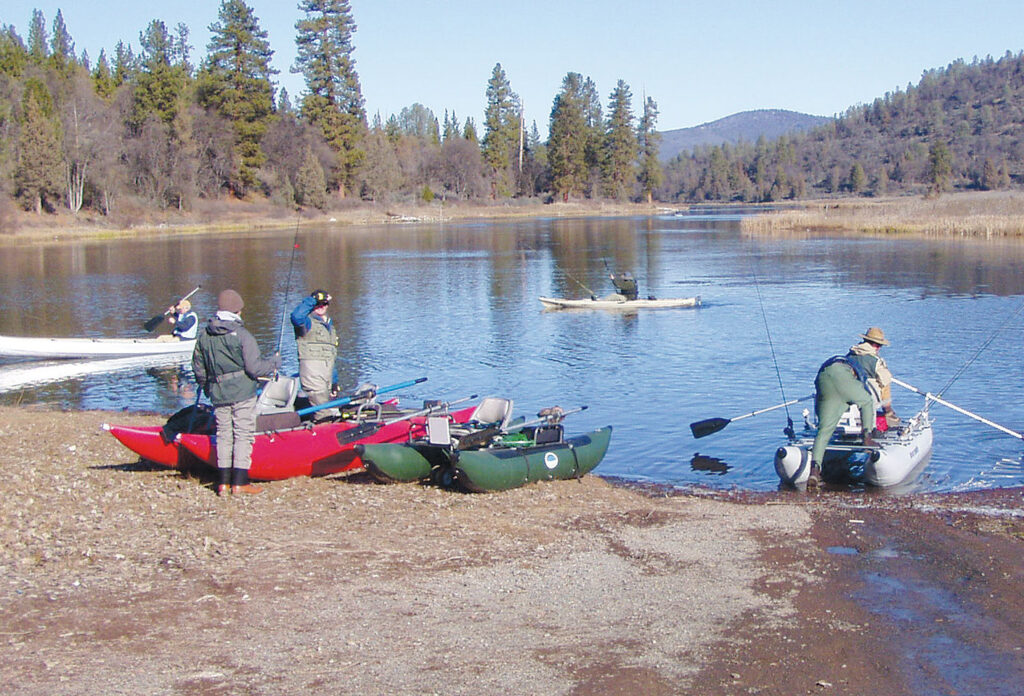
On an outing at Crowley, I caught a couple of its feisty Eagle Lake rainbows. So when our son Kirk visited us, I took him there to see if he could duplicate my modest success. He used the U-boat, I the pontoon hybrid. Fishing was slow that day. And then the wind suddenly picked up. When I looked for Kirk, he was out in the middle of the lake — don’t ask me why. Within minutes, there were whitecaps. To get back, Kirk had to kick against fierce winds, almost an impossible task. I vigorously rowed to where he could hear me, yelled, and pointed for him to go to the other shore, which meant he would be going with the wind. He got the message. In the meantime, I had a furious battle myself, rowing into the teeth of the wind to get back to the shore and my car. I then drove all the way around the lake to pick up Kirk.
For the last couple of years, I have mainly used the U-boat. It just seems more manageable and comfortable than the pontoon hybrid. I also use the smaller U-tube, with its lightness and size still providing ease of transport, entry, and exit. I also fix this one up with added floatation and seating.
Another problem that comes with fishing still waters, though, is cold feet. From the late fall on into winter, no matter how I layered my socks, my feet still would become numb after an hour in frigid water. I finally found the solution in Ultra Heat Holders socks, which have air pockets to trap the heat and ward off the cold. They work beautifully.
Still Searching
My interest in yet another craft was inspired when I checked out a little-visited lake that I discovered holds a wonderful population of large wild rainbows. To fish this water involves problems of distance and wind that make float tubing there almost impossible. Even rowing a pontoon boat or any other craft would be extremely taxing. I tried my U-boat, my pontoon hybrid, and my kayak. Only with the kayak could I get to productive water, but all of its handicaps were frustratingly present.
What caught my attention was the craft that a companion used when I brought him to this lake — a peddle kayak. His ability to reach prime water easily and with more maneuverability and stability than I had with my recreational kayak enabled him to unlock the fishing. That day, he hooked five beautiful wild rainbows up to six pounds. I finally hooked a couple, but the lack of command over my kayak and fly line still proved exasperating.
I left that outing intoxicated with this lake and its fishery (it will remain unnamed), and I started thinking about getting a peddle kayak. It would expand possibilities on some other waters, as well.
Only two companies make this kind of craft: Hobie and Native Watercraft. My companion that day has a Hobie, which can be peddled only forward. To go backward involves breaking out the paddle. But when he is trolling, he has his hands free to hold the rod, unlike with a standard kayak, in which you use both arms to paddle. He reports that wind easily alters his fishing position, since he cannot hold his boat in place when limited only to forward movements. He will use an anchor and even sit on the side of the kayak with his legs in the water to remain in control of his casting.
With the Native Watercraft peddle kayaks, you can peddle both forward and backward. Another good feature is that they are wide and stable enough so that you can stand to cast. The Hobie is also more stable than standard kayaks, and it, too, allows for standing. But I believe it takes a person with steady legs and good sense of balance to fish in this manner.
I chose to buy the smallest of the Native Watercraft models. It is 10 feet long and weighs about 70 pounds, so it is something I can pick up, carry a short distance, and place on my truck bed.
My first trial with it was anything but successful — in fact, it was a disaster. I immediately found I could not go backward and could barely go forward, because my feet kept slipping off the peddles. Even when I could gain sufficient traction to peddle forward, I had difficulty getting into a good position and holding it, as I could with a float tube. I ended the outing highly dubious that I had made a good investment. (These kayaks run over two thousand dollars.)
I decided the solution was to affix my feet to the peddles. On my next outing, I lashed my sneakers to them. With my feet so attached, I could now peddle the craft efficiently both forward and backward. And most importantly, I could line up where I wanted to cast and hold that position. However, having one’s feet affixed to the peddles is not a desirable solution. I have since taped Crocs on the peddles, an adaptation that allows me to slip my feet in and out of them easily. (I have suggested to Native Watercraft that they make this feature standard for their peddle kayaks.) With this solid peddling control, I can go fast and far and have great control and maneuverability. I foresee using this craft for most of my stillwater fishing in the future.
Other Craft
In addition to the varied craft cited above, fly fishers use several other types of craft to fish still waters, including prams, standard rowboats or river boats, collapsible Portaboats, rafts, and canoes. Except for the inflatables, these typically require more complicated transport methods, for example, a trailer. But such boats (other than a raft and a canoe) have the strong advantage of the fly fisher being able to stand comfortably with space to move about. This feature, which is also available to a lesser degree with a peddle kayak, allows the angler to be higher above the water and to spot fish better. One of my closest fishing companions, in fact, doesn’t like float tubing for this very reason: he can’t see cruising or holding fish, the way someone in a more traditional boat can.
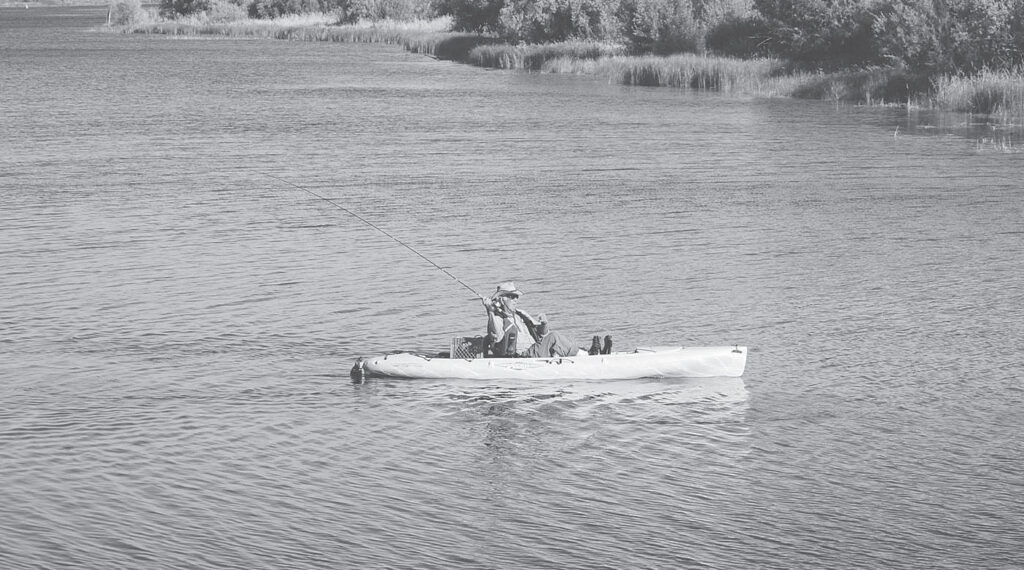
Case in point: a highly skilled fishing associate enjoys phenomenal success by motoring about (yes, he uses an outboard motor) and sighting fish that are sometimes holding together in a pod. He then casts a small nymph under an indicator near his quarry and waits ever so patiently until he gets a take. His hookup numbers are quite extraordinary.
A raft is yet another option, one that is most closely allied with a float tube or pontoon boat. The design best suited to still waters is a one-person, bottomless raft with a sturdy seat. While they provide for both rowing and kicking, their elliptical form hampers speed. One notable feature is the ease with which the fly fisher is able to stop, stand in shallow water, and fish. For other fishing tactics, they are similar to float tubes and pontoon boats.
Another way to fish still water is from a canoe. Like recreational kayaks, canoes are very efficient as transportation, but are even clumsier for fly fishing. They are also quite tippable. The appeal of both canoes and kayaks is using your own resources to glide about on the water — a rewarding activity in its own right. For serious fly fishing, they might best be used to take an angler to a location where he or she can then get out to fish.
Variety
The variety of watercraft for fly fishers to fish still waters is great, and more inventive alternatives seem to become available each year. Improvements in swiftness, comfort, and functionality mean that it is getting easier to cast a fly to fish on your favorite still waters, regardless of their location and size. And variety means adaptability. That’s why I now have so many stillwater craft.
For smaller waters, I still believe that a U-tube float tube provides the control and maneuverability that are both relaxing and productive. It does require putting on waders and flippers, getting into the water, and kicking to get about. But all in all, if you want to keep matters as simple as possible and don’t have big waters to fish, this is still a good way to go.
A pontoon boat with frame and oars appears to be the growing choice for many fly fishers. They now come in all sizes, some even capable of holding two persons. Most have an aluminum frame for rowing ease, although some newer models don’t. Several models allow kicking with flippers, as with my hybrid. Most also accommodate electric motors, a choice for many fly fishers fishing bigger waters. Fly casting from one seems easy to do, although rowing to different locations, going backward, to the side, and so forth, does interrupt fishing. There are lean, light pontoon boats that would be my choice, if I were to travel back in time. All in all, finding one that fits your personal needs seems easy with this kind of craft and probably offers the best overall choice for the fly fisher today.
As to peddle kayaks, in the half dozen times I have used mine to date, I have come to enjoy sitting down and reaching water much more quickly while staying dry. It definitely allows me to go far and fast — my original purpose in buying one. A disadvantage is that a peddle kayak weighs much more and is much more cumbersome to bring to a lake than a float tube or pontoon boat. These are not insignificant considerations, not to mention the higher cost.
So I can see myself using each of my stillwater craft (minus the doughnut), depending on where I am fishing. But the peddle kayak has definitely solved a few major issues. And I am planning on at least one more trip this fall to that secret lake — the water that precipitated this newest investment. One five-pounder would make it all worthwhile.



